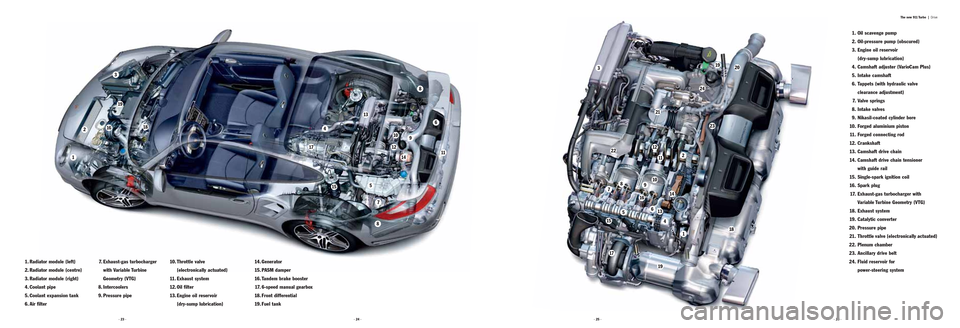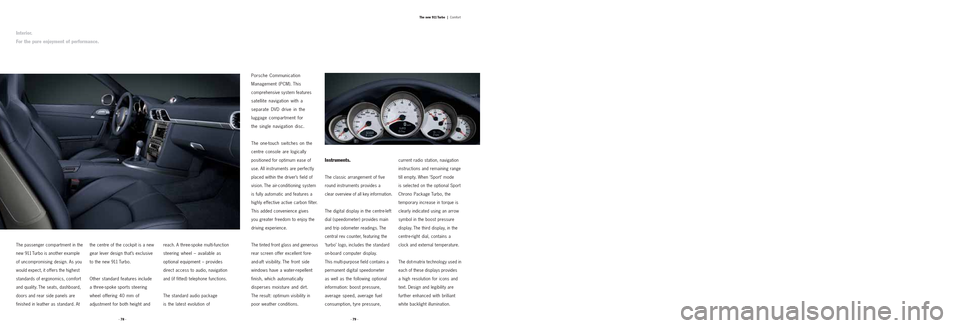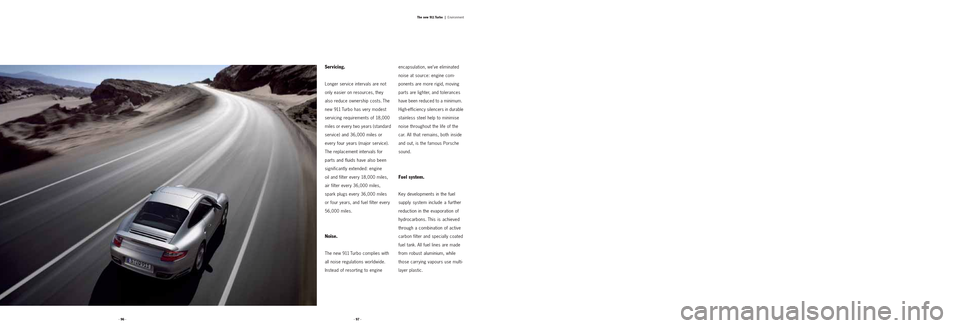fuel filter PORSCHE 911 TURBO 2004 4.G Information Manual
[x] Cancel search | Manufacturer: PORSCHE, Model Year: 2004, Model line: 911 TURBO, Model: PORSCHE 911 TURBO 2004 4.GPages: 61, PDF Size: 2.14 MB
Page 10 of 61

· 26 ·The new 911 Turbo |
Drive
· 25 · · 24 · · 23 ·
7. Exhaust-gas turbocharger
with Variable Turbine
Geometry (VTG)
8. Intercoolers
9. Pressure pipe
10. Throttle valve
(electronically actuated)
11. Exhaust system
12. Oil filter
13. Engine oil reservoir
(dry-sump lubrication)
1. Radiator module (left)
2. Radiator module (centre)
3. Radiator module (right)
4. Coolant pipe
5. Coolant expansion tank
6. Air filter
14. Generator
15. PASM damper
16. Tandem brake booster
17. 6-speed manual gearbox
18. Front differential
19. Fuel tank1. Oil scavenge pump
2. Oil-pressure pump (obscured)
3. Engine oil reservoir
(dry-sump lubrication)
4. Camshaft adjuster (VarioCam Plus)
5. Intake camshaft
6. Tappets (with hydraulic valve
clearance adjustment)
7. Valve springs
8. Intake valves
9. Nikasil-coated cylinder bore
10. Forged aluminium piston
11. Forged connecting rod
12. Crankshaft
13. Camshaft drive chain
14. Camshaft drive chain tensioner
with guide rail
15. Single-spark ignition coil
16. Spark plug
17. Exhaust-gas turbocharger with
Variable Turbine Geometry (VTG)
18. Exhaust system
19. Catalytic converter
20. Pressure pipe
21. Throttle valve (electronically actuated)
22. Plenum chamber
23. Ancillary drive belt
24. Fluid reservoir for
power-steering system
1
2
3
4
5
21
2019
19
9
6
23
24
16
11
12
14
13
22
15
17
7810
18
16
1
2
6
5
3
109
8
7
15
17
18
19
14
13
12
4
11
8
Page 18 of 61

are reduced thanks to lengthy
replacement intervals for both
the engine oil (18,000 miles) and
air filter unit (36,000 miles). The
spark plugs require changing after
36,000 miles or a maximum of
every four years. The generator,
power-steering pump and air-
conditioning compressor are all
driven by a single self-adjusting
belt with a service life of 54,000
miles. The hydraulic tappets
provide automatic adjustment of
all valve clearances, while the
drive chains on the camshafts
and auxiliary shafts will also last
the life of the car.
Basic servicing is required after
18,000 miles or a maximum of
two years on the road. The first
major service is due at 36,000
miles or every four years at the
latest. The results: lower running
costs and virtually uninterrupted
enjoyment from your Porsche.
Exhaust system.
The exhaust system on the
911 Turbo is made from highly
durable stainless steel. The
system consists of two separate
tracts, one for each bank of
cylinders. The catalytic converters
are extremely heat-resistant,
yet quick to reach temperature
(and thus optimum performance)
when the engine is started
from cold.Twin lambda sensors in each of
the exhausts enable continuous
monitoring of the combustion
process. An additional pair of
sensors* is used to measure
the efficiency of the catalytic
converters.
Servicing.
Another pleasant surprise on the
new 911 Turbo is the standard
service schedule. Running costs
The new six-speed manual
gearbox in the 911 Turbo is
specifically adapted to the car’s
high levels of engine torque.
Designed primarily for sports
driving, one immediate
characteristic is the perfectly
judged spread betweensuccessive ratios as you upshift
through the gears. The gearshift
throw is short and precise,
with only minimal force required.
Thanks to a dual-mass flywheel,
this uncompromising setup means
there’s never any compromise
in comfort. The linkage provides
a direct connection with the
gearbox while insulating
the lever from engine vibration.
One final detail – the new gear
lever design – is exclusive to
the 911 Turbo.
· 44 ·· 45 ·The new 911 Turbo |
Drive
Six-speed manual gearbox.
Superlative power requires equal precision.
Gear lever exclusive to 911 Turbo* Not in markets with leaded fuel.
Page 35 of 61

Porsche Communication
Management (PCM). This
comprehensive system features
satellite navigation with a
separate DVD drive in the
luggage compartment for
the single navigation disc.
The one-touch switches on the
centre console are logically
positioned for optimum ease of
use. All instruments are perfectly
placed within the driver’s field of
vision. The air-conditioning system
is fully automatic and features a
highly effective active carbon filter.
This added convenience gives
you greater freedom to enjoy the
driving experience.
The tinted front glass and generous
rear screen offer excellent fore-
and-aft visibility. The front side
windows have a water-repellent
finish, which automatically
disperses moisture and dirt.
The result: optimum visibility in
poor weather conditions.
Instruments.
The classic arrangement of five
round instruments provides a
clear overview of all key information.
The digital display in the centre-left
dial (speedometer) provides main
and trip odometer readings. The
central rev counter, featuring the
‘turbo’ logo, includes the standard
on-board computer display.
This multi-purpose field contains a
permanent digital speedometer
as well as the following optional
information: boost pressure,
average speed, average fuel
consumption, tyre pressure,
current radio station, navigation
instructions and remaining range
till empty. When ‘Sport’ mode
is selected on the optional Sport
Chrono Package Turbo, the
temporary increase in torque is
clearly indicated using an arrow
symbol in the boost pressure
display. The third display, in the
centre-right dial, contains a
clock and external temperature.
The dot-matrix technology used in
each of these displays provides
a high resolution for icons and
text. Design and legibility are
further enhanced with brilliant
white backlight illumination.
· 78 ·· 79 ·The new 911 Turbo |
Comfort
Interior.
For the pure enjoyment of performance.
The passenger compartment in the
new 911 Turbo is another example
of uncompromising design. As you
would expect, it offers the highest
standards of ergonomics, comfort
and quality. The seats, dashboard,
doors and rear side panels are
finished in leather as standard. Atthe centre of the cockpit is a new
gear lever design that’s exclusive
to the new 911 Turbo.
Other standard features include
a three-spoke sports steering
wheel offering 40 mm of
adjustment for both height and
reach. A three-spoke multi-function
steering wheel – available as
optional equipment – provides
direct access to audio, navigation
and (if fitted) telephone functions.
The standard audio package
is the latest evolution of
Page 44 of 61

Servicing.
Longer service intervals are not
only easier on resources, they
also reduce ownership costs. The
new 911 Turbo has very modest
servicing requirements of 18,000
miles or every two years (standard
service) and 36,000 miles or
every four years (major service).
The replacement intervals for
parts and fluids have also been
significantly extended: engine
oil and filter every 18,000 miles,
air filter every 36,000 miles,
spark plugs every 36,000 miles
or four years, and fuel filter every
56,000 miles.
Noise.
The new 911 Turbo complies with
all noise regulations worldwide.
Instead of resorting to engineencapsulation, we’ve eliminated
noise at source: engine com-
ponents are more rigid, moving
parts are lighter, and tolerances
have been reduced to a minimum.
High-efficiency silencers in durable
stainless steel help to minimise
noise throughout the life of the
car. All that remains, both inside
and out, is the famous Porsche
sound.
Fuel system.
Key developments in the fuel
supply system include a further
reduction in the evaporation of
hydrocarbons. This is achieved
through a combination of active
carbon filter and specially coated
fuel tank. All fuel lines are made
from robust aluminium, while
those carrying vapours use multi-
layer plastic.
· 96 ·· 97 ·The new 911 Turbo |
Environment